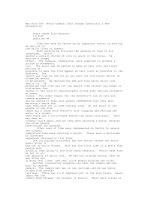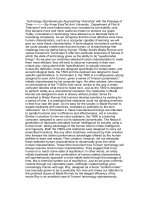technology spontaneously approaching humanity with the passag
Bạn đang xem bản rút gọn của tài liệu. Xem và tải ngay bản đầy đủ của tài liệu tại đây (36 KB, 4 trang )
Technology Spontaneously Approaching 'Humanity' with the Passage of
Time By Avner ErezTel Aviv University , Department of Film &
TelevisionTools once helped early man increase his survivability, and
they became more and more useful as means to achieve our goals.
Today, innovations in technology have allowed us to fabricate tools of
increasing complexity. As we recognize that the most effective tools have
human characteristics, such as a computer capable of learning, we will
give our tools these characteristics. If technological innovations continue,
we could actually create tools that are human, or at least beings that
challenge how we define being 'human.' Ridley Scott's Blade Runner and
James Cameron's Terminator 2 offer two particular scenarios of futures in
which the state of technology gives us the ability to do "questionable
things." As we give our machines selected human characteristics to make
them more efficient, they will tend to discover humanity in their own
unique way, rising above their 'specifications' to actually become
human.By definition, tools are designed specifically for certain tasks, and
as technological tools, the T800 and the replicant are deigned to meet
specific specifications. In Terminator 2, the T800 is a multipurpose cyborg
assigned to save John Connor, given a series of "mission parameters,"
initially characterized by his computer logic. He often advises John based
on permutations of the T1000's next move, similar to the way a chess
computer decides what move to make next. Just as the T800 is designed
to perform solely as a unemotional computer, the 'replicants' in Blade
Runner are designed to work in slavery without protest. Since it's
remarked in Blade Runner that humans develop emotions by existing for
a period of time, it is predicted that replicants could not develop emotions
in their four year life span. So it's easy for the society in Blade Runner to
equate replicants with machines, indicated so politically by the term
'retirement.' As in Terminator 2, these manufactured beings are intended
to parallel humans only in efficiency and effectiveness, not in emotion.
Similar in practice to how we solve problems, the T800 is a learning
computer, designed to carry out its objectives dynamically. The Nexus 6
generation of replicants simulates human intelligence by actually using a
human brain, taking advantage of the human brain's innate intelligence
and ingenuity. Both the T800s and replicants were designed to carry out
prescribed functions, like any other machines, enhanced by their creators
who foresaw the distinct performance advantages offered by the human
abilities to learn and reason.Their creators, however, did not anticipate
these selected human characteristics to dynamically grow into other
human characteristics. These films document how 'human' technology will
always assume more human characteristics. They suggest that to be
human is to reach some state of equilibrium. In other words, an entity
initially bestowed with any combination of human related characteristics
will spontaneously approach a more stable state through the passage of
time, like a chemical system out of equilibrium. Just as we grow uniformly
content through our venerable years, artificially created beings grow
increasingly human with age. Roy, designed as a fierce "combat model,"
has ironically grown to be a poetically rich man and draws our attention to
the pertinent issues of Blade Runner by the elegant efficiency of his
words.Roy is an excellent case of 'human' technology spontaneously
evolving to become truly human. His quest to extend his and his
comrades' lives shows that he well understands the richness of life. He
relishes every moment of his life, and he makes tactful commentaries
relating them to the irony of his present situation. "It's not an easy thing to
meet your maker," Roy sardonically observes upon confronting Tyrell,
prompting us to consider the implications of such a meeting between
creator and created. Following Tyrell's remark, "you've done extraordinary
things," Roy sarcastically replies, "nothing the god of biomechanics won't
let you in heaven for." Roy, resentful that he is arguably less than human,
is using tragic sarcasm to describe Tyrell receiving credit for Roy's
accomplishments, like the way an inventor receives credit for his
invention's accomplishments. Roy has become so deeply enriched with
the feeling of being emotionally alive, he sees no better way to express
the inexpressible poetically. In his final soliloquy atop a building in the rain
with Deckard, Roy recounts his most triumphant moments and
acknowledges a great sadness within him. He reluctantly foresees that
"all those moments will be lost" at his death, understanding the tragedy
and hopelessness of his and his comrades' situation. Roy has grown into
a philosopher, transfixed by his human desire to live like any other.Roy's
comrades also have come so very far. In their few years, they've grown
dynamically, as any intelligent beings would, to assume a more
steady-state we call 'humanity.' As the diversity of their personalities
unfolds in Blade Runner, it becomes clear they've acquired healthy
human qualities. Zhora, a replicant model designed to kill, ironically
chooses to dance for men while Pris, the "pleasure model," seems to
have a more sinister personality, with her painted face. When Leon
discovers his lover, Zhora, was shot and killed by Deckard, a deep
"human" rage consumes him, these emotional responses providing
unmistakable proof for true human qualities that lie beneath Once
emotionless shells in their early years, they have spontaneously acquired
their own personalities.The T800, in Terminator 2, is shown to grow in this
same way. However, he grows to a lesser extent because this film takes
place in the infancy of his development. In Blade Runner, Roy and his
comrades have already been alive for three and a half years, in contrast
to the T800's few weeks. When replicants are created, they have no
emotional response and no understanding of humanity because Tyrell
explains these qualities are learned. More specifically, he describes how
emotional response results from accumulated memories. Similar to a
newly created replicant, a newly created T800 acts solely on binary logic
because it has no past experiences from which to draw. Since the T800
and a replicant start identically in this way, we can treat the two as one
and the same. Therefore, the newly created T800 in Terminator 2 could
easily be substituted with a newly created replicant. Likewise, Roy's
poetic words in Blade Runner could very well be the T800's words,
provided the T800 has lived long enough. Between the two films we have
a consistent, continuous documentary of 'human' technology from its
infancy to its maturity.The process that causes 'human' technology to
assume a more true human form is dynamic, changing at a rate
depending on the degree to which it has already changed. Such a
process implies an exponential curve, characterized by a extremely slow
rate of change at the time short after their creation followed by rapid
increases. The T800 is extremely slow to understand John's justification
for why "you just can't go around killing people," because a purely logical
brain cannot impose new boundaries on its decisions without parameters.
In other words, logical reasoning requires that all its priorities have logical
explanations. Accordingly, the T800 queries to obtain such a logical
explanation, asking "Why not?" Because of the enormous complexity of
this issue coupled with the youth of his own years, John can only reply, "I
don't know-you just can't!" With such a flimsy logical defense of life, it's
understandable why the T800 cripples the next potential victim
commenting, "he'll live." However, when he restricts his gunfire to
subduing gunfire, in the Cyberdyne building scene, destroying the police
transportation and tear gassing the police officers, we finally see how
quickly he's able to learn. Not less than thirty minutes later, just before the
T800 lowers himself to die, he has learned enough to tell John, "I
understand why you cry now." If he would have lived, his growth rate
would continue on its trend, turning from small steps to leaps and
bounds.Tyrell describes memories to be the very heart of emotions.
Because replicants early in their life have no memories, and thus no
emotions, society considers them as mere machinery. As Tyrell
recognizes that humans are different from replicants only by the
memories they carry, he designs an experiment to test this theory. Rachel
is an experimental replicant, implanted with false memories designed to
make her believe she grew up like any other. With memories to furnish
her emotions, Rachel was human from the moment of her 'birth.' When
she learns of her replicant heritage, she is devastated, as any person
would be, and ironically grieves in human ways. She numbs from the
shock, in a haze from her personal world suddenly crumbling to dust. We
would no doubt react in a similar way if we were suddenly told we were
replicants. In other words, even in her defeat, she brilliantly fits Tyrell's
"more human than human" slogan. Rachel is the end stage, the
equilibrium stage, of the evolution of 'human' technology. At this stage,
she is emotionally complete from a wealth of memories and is completely
indistinguishable from her human creators, for she truly is human.Just as
these films document how 'human' technology approaches the state of
'human' equilibrium, they support its implications as well. If all 'human'
technology will tend to spontaneously approach humanity, then we should
logically see evidence of a turning point: a point when the technology
denies its preprogrammed purpose to better pursue human goals. Roy
and the others reach this point when they throw down their enslavement
to pursue a more promising and fulfilling future. Reaching a crossroads in
their lives, they chose to pursue humanity, the moment they chose to
hijack their transport shuttle. In a similar way in Terminator 2, Skynet, the
national defense's intelligent super computer "decided our fate in a
microsecond" when it initiated a nuclear strike to kill most of the world's
population. How could a computer grow to make such a decision?
Although John teaches the T800 why its wrong to kill, no one ever taught
Skynet the value of human life, for it was only programmed to preserve its
own. Having not been taught the value of human life, Skynet grew to
misinterpret its purpose of maintaining a strategic superiority over other
powers, deciding the best strategy to assure its own survival was to
eliminate all threats. Like all the 'human' technology in these films, it grew
in way related to what it was initially taught, that is, it grew
dynamically.Given the proper time, artificially intelligent technology will
always deviate from its intended purpose to pursue a more preferable
existence. Because Terminator 2's T800 and Blade Runner's replicant
both suffer the consequences of not having memories when they are
created, they grow in an identical way. This justifies why Terminator 2 and
Blade Runner are actually different segments present parts of a single
story. Between the two films, they outline three key phases of 'human'
technology's spontaneous tendency to reach a more steady state. It first
experiences a period of transition as its mind learns how to understand
philosophical issues, such as how the T800 learns to understand life's
uniqueness. Next, it dynamically changes as it interactively uses what it
has already learned to learn more. Roy has come infinitely far from a
thoughtless soldier, contemplating the nature of his human surroundings
and longing for days he can peacefully breathe in the world around him.
Finally, it lives long enough, or at least think it has in Rachel's case, to
truly reach a state of equilibrium we call 'humanity.' Like any state of
equilibrium, it is not possible for the process to be reversed, just as it is
not possible to reverse the beating of an egg. On a smaller scale, each of
us converges on a more tranquil state of mind, perhaps best illustrated by
the peaceful smiles we remember on our grandparents' faces. This
analysis predicts only one outcome if the human race develops the ability
to create technology capable of learning and reasoning. Like a marble
resting on a slant, if this 'human' technology is subjected to any outside
impetus, it will accelerate towards a more stable ground, a section of
asphalt we have colorfully chalked, 'humanity.'









